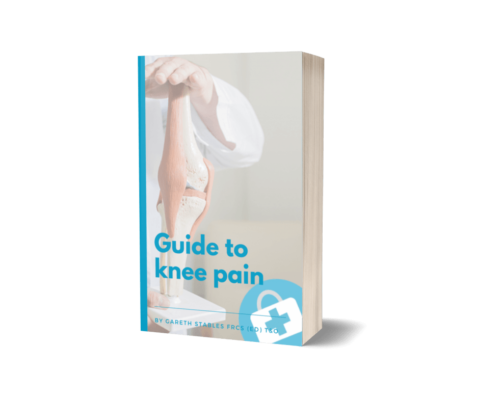What is Knee Bursitis?
Knee bursitis happens when your bursa becomes inflamed. Bursa are small fluid filled sacs that reduce the friction between two surfaces. They are found all over the body, and sit between your bones and your muscles, tendons or skin. Bursitis in your knee usually results in pain and swelling around the front or the side of your knee.
What are the causes of knee bursitis?
There are a number of things that can cause knee bursitis and specialist knee surgeon and clinical director of the My Knee Doc knee clinics Gareth Stables will explain further in this post.
Repetitive pressure
If your knee is constantly put under a lot of pressure your bursa will produce more fluid. It does this in an effort to protect your knee.
This happens more commonly in people who spend a lot of time kneeling such as carpet fitters, electricians and plumbers.
Another reason why your bursa can become inflamed is if your muscle or tendons are tight and they push down on it causing irritation.
Repetitive friction
Another reason for a bursa to become inflamed is when People take part in activities which involve a lot of jumping or running this can cause friction and irritation leading to inflammation of your bursa.
Can an injury lead to bursitis?
A sudden blow or a fall onto your knee can damage your bursa and lead to swelling and inflammation. This can sometimes set up a vicious cycle of swelling leading to more friction leading to more inflammation.
What are the different types of knee bursitis?
There are many bursa around your knee However commonly people suffer from one of three types of knee bursitis.
- Prepatellar bursitis - Your prepatellar bursa is found directly in front of your kneecap under your skin. Prepatellar bursitis is commonly known as housemaids knee and causes pain and swelling at the front of your knee joint. It is commonly found in people who spend a lot of time kneeling.
- Pes Anserine bursitis - Pes Anserine bursitis occurs on the inner side of your knee. The pes anserine bursa sits between your medial collateral ligament and your hamstring tendons as they attach onto the top of your shin bone. Pes Anserine bursitis of the knee usually develops from overuse and most commonly affects runners.
- Infrapatellar bursitis - This is sometimes called preachers or clergyman’s knee. It causes pain and swelling in front of your patella tendon .
- Iliotibial bursitis - Iliotibial bursitis occurs on the outer side of your knee. Your iliotibial bursa lies between the iliotibial band and the bones on the outside of your knee. This is often missed diagnosed as iliotibial band syndrome.
How can I treat knee bursitis?
As with many things prevention is often better than cure. To prevent getting prepatellar bursa situs it’s useful to consider using gel knee pads particularly if you are doing a lot of kneeling.
Making sure that you have good strength and balance in your muscles. Getting advice from a knee specialist or a physiotherapist sooner rather than later can stop the problem becoming chronic.
For some people the bursitis doesn’t improve with simple treatments and can occasionally they need treatment such as specialist platelet rich plasma injections or in very rare cases even surgery.
How can I get help with my knee bursitis?
As with any condition it’s important to get the right diagnosis and the right advice and treatment sooner rather than later. Often if diagnosed early knee bursitis will respond to non-invasive treatments such as physiotherapy. If things aren’t settling then here at the My Knee Doc clinic we offer treatments such as specialist platelet rich plasma injections which can speed up your recovery.
If you’d like to find out more about how we can help or if you just want to speak to our specialist knee surgeon Mr Gareth Stables then click here and arrange your free call back.


